If you notice yellow spots on cucumber leaves — sound the alarm. One of the diseases with such symptoms is cucumber anthracnose. Without timely treatment, it can completely destroy your harvest.
Read about the symptoms, causes, treatment, and prevention of cucumber anthracnose — in our article.
Table of contents
What is this disease?
Cucumber anthracnose (see photo) — is a fungal disease that affects the entire plant, including leaves and fruits. Gardeners often call this disease by its other name — copperhead. The causative agent of anthracnose is the fungal bacterium Colletotrichum.
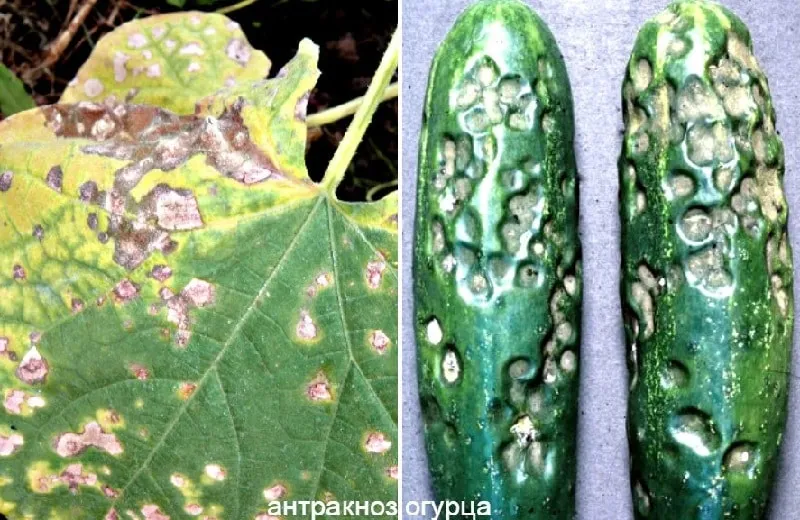
The disease occurs everywhere — both in open and protected ground. Cucumbers grown in greenhouses are more susceptible to anthracnose. However, it can easily attack plants in outdoor gardens as well.
The disease affects cucumbers at all stages of growth. The first symptoms may appear even on seedlings. Besides cucumbers, anthracnose also targets tomatoes, raspberries, strawberries, currants, grapes, cherries, and other crops.
Symptoms of anthracnose
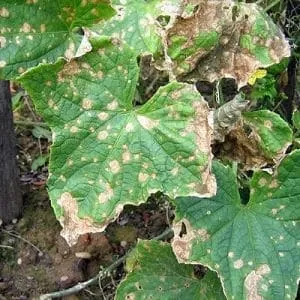 Anthracnose appears on all above-ground parts of plants (both young and mature), but fruits are particularly affected. On seedlings, the disease manifests as sunken brown spots near the root collar. Symptoms on mature plants are easier to recognize.
Anthracnose appears on all above-ground parts of plants (both young and mature), but fruits are particularly affected. On seedlings, the disease manifests as sunken brown spots near the root collar. Symptoms on mature plants are easier to recognize.
Leaves
Initially, pale green spots about 3 mm in diameter appear, which later merge into larger ones — up to 4 cm. Over time, the spots turn copper-brown, the leaf darkens, becomes brittle, and dries out in dry weather or rots in high humidity. Holes often form in the affected areas.
Fruits
Sunken, oblong spots resembling light-brown ulcers of varying sizes appear on the cucumbers. The fungal mycelium penetrates 3-4 mm deep into the fruit. The cucumbers become bitter, later darken, and rot. Such fruits are unsuitable for sale or consumption.
Stems
They develop weeping, elongated, sunken spots of brown-yellow color. In affected areas, the stem thins and breaks, leading to plant death.
In high humidity, infected plant parts develop a pink coating — fungal spores. Later, black dots (sclerotia) appear.
Danger and damage caused
Anthracnose spreads quickly and affects all parts of the plant. The disease reduces both the quality and quantity of the harvest. If the fungus spreads unchecked, plants may die. Fruits lose organic acids and sugars, becoming bitter and rotting.
The fungus is widespread, but it causes the most damage to cucumbers in polytunnels and open fields. Typically, yield losses range from 6% to 48%, and in some years, they can reach 55%.
Causes of the disease
Anthracnose spreads via wind, rain, and insects. Often, its sources are infected seeds and plant debris. The fungus can also persist on greenhouse surfaces where infected plants were grown.
Additionally, fungal spores spread from infected to healthy plants during watering or direct contact. Weakened plants in polytunnels or open fields are most vulnerable to anthracnose.
The fungus thrives in high humidity (90%) and warm temperatures (22-27°C). Soil where anthracnose develops is acidic and deficient in potassium and phosphorus. The fungus lives and grows at temperatures between 4°C and 30°C. However, at air humidity below 60%, the disease remains dormant.
Treating cucumbers
To save the plant and harvest a healthy crop, you must not ignore anthracnose. The earlier you detect and treat the disease, the fewer losses you’ll suffer.
Various methods exist to combat cucumber anthracnose: agronomic practices, home remedies, and chemical treatments. The latter are the most effective but also the least safe. Unfortunately, agronomic methods alone won’t eradicate anthracnose.
Agronomic practices
Agronomic methods are better suited for prevention and stopping the spread to healthy plants. These include crop rotation, removing plant debris, disinfecting greenhouses, etc.
Before transplanting seedlings, carefully inspect each plant for anthracnose symptoms. Remove infected sprouts immediately.
To prevent the disease from spreading among mature plants, carefully remove and burn infected bushes.
If you detect early signs, you can halt disease progression by reducing air humidity to 60%. However, this only stops — not cures — the disease.
The only effective agronomic method against anthracnose is root drenching with 1% Bordeaux mixture. First, water the soil around the plant thoroughly, then apply the solution (1 L per plant) to the roots and stem base. Repeat every 2-3 days until the fungus is eradicated.
Home remedies
Home remedies are used to disinfect seeds before planting. First, thermal disinfection: soak seeds in hot water (60°C) for 5-6 hours, then in cold water for 2-3 minutes.
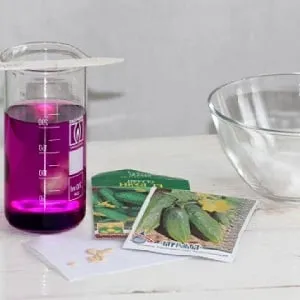 Second method — sterilization in potassium permanganate. Dissolve 1 tsp of powder in 600 mL of water and soak seeds for 20 minutes. Rinse afterward.
Second method — sterilization in potassium permanganate. Dissolve 1 tsp of powder in 600 mL of water and soak seeds for 20 minutes. Rinse afterward.
Third method — natural fungicides like mustard, aloe, or herbal alcohol tinctures:
- Soak seeds in a 2% mustard solution for 6 hours or in herbal tinctures for 1 hour.
- Refrigerate aloe leaves for 5-6 days, extract juice, dilute 1:1 with water, and soak seeds for 24 hours.
Note: Treating mature plants with home remedies is widely considered ineffective.
Some gardeners prefer a less harmful approach: first, treat infected plants with 5-7% copper sulfate, then apply a paste of honey, lime, and charcoal to affected areas.
Root drenching with Bordeaux mixture (mentioned earlier) is also considered safe.
Chemical treatments
To combat early-stage anthracnose (in infected seeds), use the fungicide Thiram. Treat seeds 2-5 days before planting (4.5 g per 2 kg of seeds).
Alternatively, soak seeds before planting in solutions of "Immunocytophyte" or Thiram.
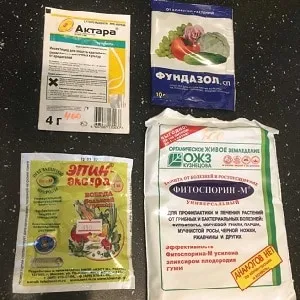 For mature plants, use fungicides. The most effective include:
For mature plants, use fungicides. The most effective include:
- "Fitosporin": Powder — 10 g per 5 L water (3 sprays, 10–15 days apart). Paste — 4 drops per 200 mL water. Liquid — 10 drops per 20 mL water.
- "Previcur": 1.5 mL per 1 L water.
- "Abiga-Peak": 40–50 g dissolved in 1 L water, then diluted to 10 L. Apply 3-4 times per season, 20–30 days apart.
- "Quadris": 5 mL per 10 L water. Up to 3 treatments.
- "Thiovit Jet": 30–80 g per 10 L water.
- "Fundazol": Used for watering, spraying, or seed treatment. 1 g per 1 L water. Maximum 2 sprays per season. Treat seeds a month before planting.
Important! Always read the instructions. After chemical treatment, harvest only after 5–30 days (depending on the product).
Follow safety precautions when using chemicals. Wear protective clothing, a respirator, goggles, and gloves. After treatment, discard gloves and wash thoroughly with soap.
Do not store prepared solutions. Note: some fungicides repel pollinators, so avoid using them during flowering.
Treatment in greenhouses
Greenhouse plants are most vulnerable to anthracnose:
- First, greenhouse conditions favor fungal growth: warm temperatures combined with high humidity.
- Second, the fungus often lingers on greenhouse surfaces, reinfecting new plants. Always disinfect greenhouses post-harvest and before new plantings.
- Third, close plant spacing in greenhouses accelerates fungal spread.
The advantage of greenhouse treatment is controllable humidity. At the first signs of fungus, reduce humidity to 60% to halt disease progression. Then apply fungicides as directed.
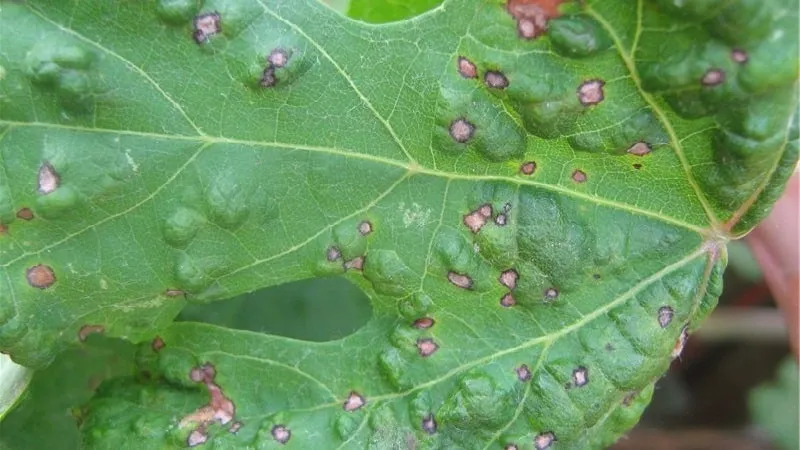
Treatment in open fields
In outdoor gardens, infection usually occurs via seeds, wind, or insects. Contaminated soil and plant debris can also spread anthracnose.
For open fields, root drenching with 1% Bordeaux mixture is most effective. Spray fungicides early morning (before 10 AM) or evening (after 6 PM) to avoid sunburn. Choose dry, windless days.
Check the weather forecast before spraying — rain will wash away the treatment prematurely.
Preventive measures
Since anthracnose spreads rapidly, prevention is key. Regularly inspect plants to catch early signs:
- Plant seeds only from healthy crops, bought from trusted suppliers. Choose anthracnose-resistant varieties.
- Before planting, calibrate seeds and use fungicides to disinfect them.
- Follow crop rotation: wait 4 years before replanting cucumbers in the same spot.
- Remove and burn infected plants. Post-harvest, burn vines, deep-dig soil, and clear debris. In greenhouses, replace the top 10 cm of soil.
- Disinfect greenhouses after harvest and before new plantings.
- Enrich soil with potassium, phosphorus, organic matter, and biopreparations.
- Sterilize soil and garden tools.
- Control moisture in polytunnels. Ensure proper ventilation. Space plants apart to limit fungal spread.
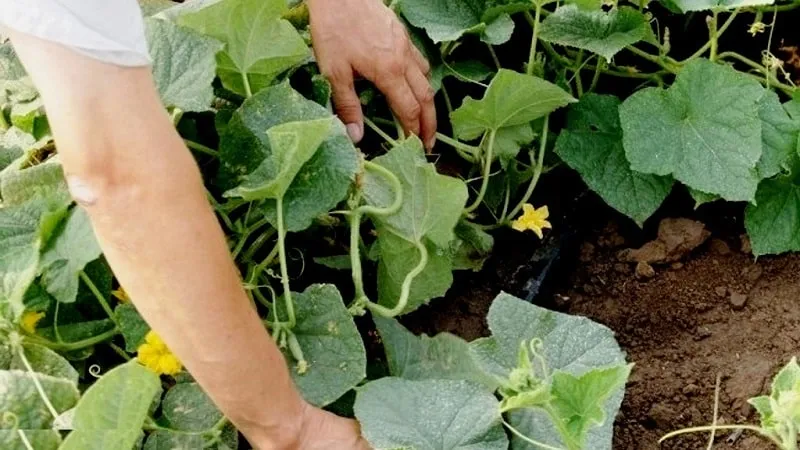
Helpful tips
Expert gardener Emma Bridgewater recommends spraying greenhouse plants with potassium permanganate, followed by dusting leaves with mustard powder or ash.
Use Bordeaux mixture at 1 tsp per 5 L water — one of the most effective treatments for outdoor cucumbers.
Regularly inspect plants and remove infected leaves (especially lower ones) to curb disease spread and improve airflow.
Don’t avoid chemicals — they’re the only proven way to eradicate anthracnose.
Conclusion
Anthracnose is a common fungal disease affecting vegetables, especially cucumbers. Due to its many transmission routes, prevention is challenging. Prioritize crop rotation, seed/soil disinfection, and greenhouse hygiene. Act fast at the first symptoms — early treatment minimizes losses.
Always follow chemical instructions and safety guidelines. Remember: post-treatment harvests are safe only after 5–30 days.







